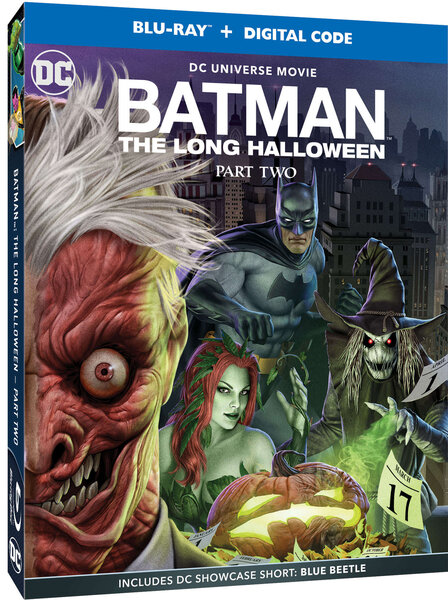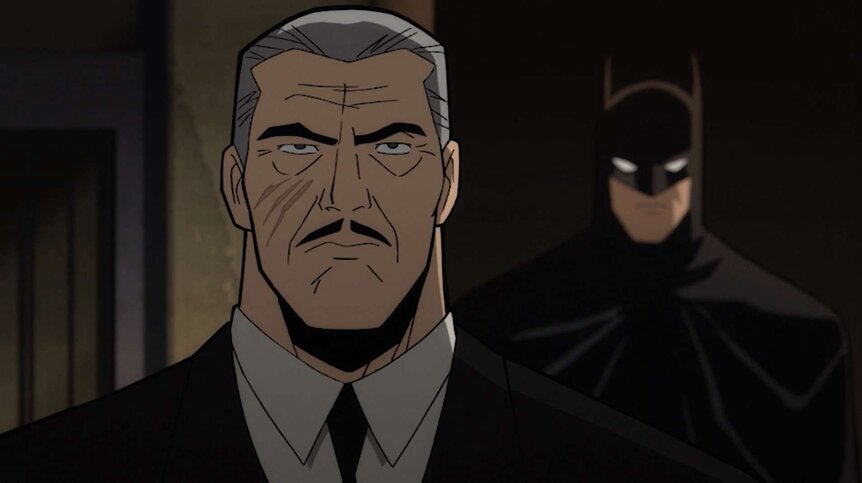Create a free profile to get unlimited access to exclusive videos, sweepstakes, and more!
'Batman: The Long Halloween' two-parter was written as though it were a live-action movie

Screenwriter Tim Sheridan never intended to receive two separate ratings for his Batman: The Long Halloween script that was broken up into a pair of DC Animation features. Part One (now available on digital and Blu-ray) was given a PG-13 classification, while Part Two (available on digital today) was branded with an R for "some violence and bloody images."
"Our goal was just to make a story that is a cinematic version of The Long Halloween. As close as we could get," Sheridan tells SYFY WIRE. "I said, ‘I’m gonna write a live-action Long Halloween script. This is going to be a script that we could produce for live-action, but we will end up animating it.' It helped in the process for me because I wasn’t writing, let’s say a kids’ cartoon — I was writing a serious, adult, live-action adaptation of The Long Halloween."
The writer goes on to describe Part Two — which chronicles the birth of Harvey Dent's Two-Face (voiced by Josh Duhamel) — as a "juggernaut" and "this fast-moving train with a lot of stuff happening." While the ratings disparity was not planned for, he's incredibly pleased with the finished product, which unintentionally ended up representing Dent's split psyche and Two-Face's penchant for deciding a person's fate by flipping a coin.
"The first part is very much the clean, pristine side of the coin and then the second part is the marred-up side of the coin. The dirtier part of the story," Sheridan explains. "As the costumed villains begin their reign as ushered in by — as we know at this point — Two-Face ... In some ways, it’s kind of a happy accident for me because the ratings of the PG-13 and the R really represent those two sides of the coin. It is faster and dirtier and darker in Part Two and so, the R seems to represent that."
"Part Two has a lot more going on than Part One," adds supervising producer Butch Lukic. "Part One was the slow end of the story, but with Part Two, everything gets ramped up. So, obviously the violence and murders and also the number of characters involved now. It’s almost like any other sequel that gets ramped up."
Based on the iconic, 13-issue storyline from writer Jeph Loeb and artist Tim Sale, Batman: The Long Halloween takes place during Batman's early days as the Caped Crusader. During that time, Bruce finds his footage as the world's greatest detective while hot on the heels of a murderer who perpetrates a gruesome homicide in honor of every major holiday on the calendar.
"There’s no way to do a one-for-one adaptation from the panels to the screen and frankly, I wouldn’t want to see that," Sheridan says. "I think that the book is beautiful and it exists and people should go back and read the book. Hopefully, this movie inspired people to pick up the book — either for the first time or again, and really get to experience Jeph and Tim’s incredible work of art that is The Long Halloween."
The production dialed down some of Sale's more exaggerated character designs for the film adaptation, but made sure the artist's rendition of Gotham carried over. "I wanted Gotham City to have that feel of being its own character too," Lukic continues. "We adapted quite a bit from Tim Sale’s backgrounds and things like that."
Working alongside Dent and Jim Gordon (Billy Burke), the young Dark Knight (Jensen Ackles) attempts to track down the Holiday Killer and stem the rise of costumed villains who are fast ushering out the old guard of Gotham criminals. That noble effort pretty much falls apart, however, when Dent has acid thrown in his face and joins the ill-intentioned crowd he once sought to take down.
"We get a chance to see this guy in his full origin story and how he came to be. I don’t think we’ve ever seen him married and his home life and what was going on; some of the reasons why he was starting to snap," Duhamel says. "I think he had real troubles at home, trying to make his marriage work and trying to do his job and the frustrations that come with that. You can just kind of feel this thing coming. There was this impending crack — you could feel that something was off with this guy. When he becomes Two-Face … you can sort of understand why he came to be who he was. And that was a really fun thing to do."
Voicing Harvey was quite for the treat for Duhamel, who, for all intents and purposes, got to play two different characters wrapped up in one role. The real voiceover challenge reared its burnt visage when it came time to record dialogue for Two-Face.
"I depended on [voice director Wes Gleason] a lot to help me with that," the actor recalls. "We wanted to approach it like, ‘Physically, what would happen to you if you had something like this happen to your face? How would it affect the way you speak? Would it damage your vocal cords?’ We tried to really make him feel like he had some serious physical damage after that happened. That’s what we tried to get to. It took us a while to find it."
Duhamel also gives a lot of credit to the efforts of director Chris Palmer, calling him "a really straightforward dude. He doesn’t give a lot of direction. He trusts you and if he likes something, he just moves right on. But he’s also very specific about what he wants. He doesn’t necessarily want these big performances, he wants it to feel real."
The decision to split the animated project into two installments definitely paid off. Part One currently holds a perfect 100 percent score on Rotten Tomatoes and it looks like Part Two is receiving similar acclaim. Will DC Animation start to make a habit out of producing multiple films out of one storyline?
"It depends on what story we’re talking about," Lukic says. "Obviously, if it’s a big story like Kingdom Come and things like that, yeah — you’d have to adapt it into two or three movies … Even Red Son; that could’ve stretched out to a longer adaptation, but Bruce [Timm] was able to do it in one, and that’s good. It’s the bigger ones with multiple characters that probably require two parts."
Sheridan echoes that sentiment while adding that The Long Halloween really needed the expanded treatment, given the fact that its story is inherently rooted in the passage of time.
"In one short movie, we would’ve been jumping a month ahead every two minutes in the movie to get to the next thing that has to happen," he says. "I think it would’ve been a very jarring experience, so happily, it was an organic thing from the storytelling perspective before the script was even written we decided, ‘This is gonna have to be two movies.’"
In some cases, the monthly nature of the comic book arc worked against the cinematic translation. For instance, the halfway point of the original Long Halloween run (it ran between 1996 and 1997) featured a Riddler-centric issue that provided a recap of all the Holiday Killer suspects.
"We tried putting that beat into the story [but it] really just stopped the movie dead," Sheridan reveals. "We didn’t need the recap at that point and it’s a really tough decision, but in order to be faithful, ultimately, to the larger story of The Long Halloween, we had to make some serious decisions about what to do with that. What made it easier was that there was a plan in place and a script was written for a short that would involve [the] Riddler story that we were gonna produce and release with the film at a certain point. My understanding is that is not getting produced at this point."
And, don't you dare turn the movie off during the credits of the second movie!
"I think the thing about The Long Halloween is the story has always been about Batman’s world getting bigger," Sheridan continues. "We see that in The Long Halloween — the transition from the old gangsters who run the city ... to the costumed rogues who we know Batman is going to really fight for a long time throughout the city. Well, if you stick around the credits, you’ll get a sense of how Batman’s world is about to get even bigger."
"I love the dark, film noir tone that this thing has," Duhamel says of Part Two. "They let it breathe, the silence speaks volumes in a lot of ways. And that takes a lot of courage for a filmmaker to trust that — that the audience isn’t gonna tune out. I love that kind of stuff. I love when it’s not overly produced and overly sound-designed ... The story is cool. It’s dark, it’s edgy, it’s adult, it’s sexy. It pushes the envelope…and why not?"
Batman: The Long Halloween, Part Two is now available to purchase digitally for $19.99. The film arrives on Blu-ray ($34.98) on Tuesday, Aug. 10. Click here to watch an exclusive clip from Part Two.
The voice cast also features the late Naya Rivera (Catwoman), Katee Sackhoff (Poison Ivy), Titus Welliver (Carmine Falcone), David Dastmalchian (Calendar Man and The Penguin), Troy Baker (The Joker), Robin Atkin Downes (Scarecrow and Thomas Wayne), and John DiMaggio (Mad Hatter).





























